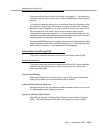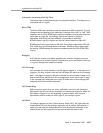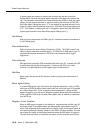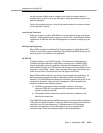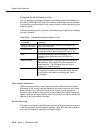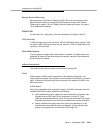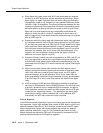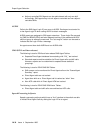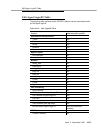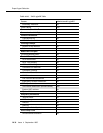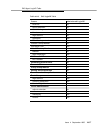
Expert Agent Selection
10-32 Issue 4 September 1995
■ Direct Agent third-party make calls (ACD calls terminated to a selected
member of an ACD skill group) may be requested by including a Direct
Agent option, an agent’s physical extension and a skill group extension
(compatibility mode), or by requesting a user-classified third-party make
call with a Login ID destination. The primary differences between the two
methods of requesting Direct Agent calls are that the compatibility mode
allows the adjunct to specify the skill hunt group to which a given Direct
Agent call is queued and that the non-compatibility mode allows the
adjunct to direct the call to a Login ID, regardless of which station an
agent is logged into. Direct Agent third-party make calls may not originate
from an EAS Login ID.
■ Supervisor assist third party make calls (supervisor assist calls originated
by a selected member of an ACD split) may originate from an EAS Login
ID, and they may terminate to an EAS Login ID. Unlike dialed Direct Agent
calls, supervisor assist calls terminated to a Login ID behave as though
they have been previously directed to the requested Login ID’s physical
extension (for example, they do not cover if the requested agent is not
logged in and if the originator’s display shows the agent’s physical
extension and not the agent’s Login ID).
■ Extension (Domain) control may not be requested for an EAS Login ID, but
it may be requested on behalf of a Logical Agent’s physical extension.
Auto-dial calls (calls initiated by an extension-controlled station) may be
terminated to an EAS Login ID, in which case the call is given Direct Agent
treatment.
■ Adjunct routing calls (vector calls routed by an ASAI adjunct via the
adjunct routing
Call Vectoring command) are similar to third party make
calls. Such calls may include a Direct Agent option, an ACD agent’s
physical extension, and a skill extension. If this is true, these calls are
given compatibility mode Direct Agent treatment and may be terminated
to an EAS Login ID (in which case they behave like dialed Direct Agent
calls).
■ If EAS is optioned, ASAI launches OCM switch-classified or predictive
calls from a VDN extension via the OCM/EAS feature. On the other hand,
to launch a predictive call in a traditional ACD environment, an adjunct
OCM application sends to the switch an ASAI request with an ACD split
number as the ‘‘originating number.’’ The application also sends flags
identifying the call as a switch-classified call. In the traditional ACD
environment, the ACD split cannot be vector-controlled.
Feature Requests
In the EAS environment, agent login, logout and change work-mode requests are
fully supported. Agent login requests must contain an EAS Agent Login ID and
optional password (delimited by ‘#’) in the login request’s user code IE. Agent
logout requests and change work-mode requests may contain the desired
agent’s physical extension or Login ID. Call Forwarding and Send all Calls
feature requests are denied for EAS Login IDs but may be requested for EAS
physical extensions where an EAS agent is logged in.




